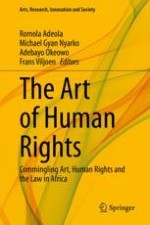
2019 | OriginalPaper | Chapter
1. Arts, Human Rights and the Law in Africa: An Introduction
Authors : Romola Adeola, Michael Gyan Nyarko, Adebayo Okeowo, Frans Viljoen
Published in: The Art of Human Rights
Publisher: Springer International Publishing
Activate our intelligent search to find suitable subject content or patents.
Select sections of text to find matching patents with Artificial Intelligence. powered by
Select sections of text to find additional relevant content using AI-assisted search. powered by